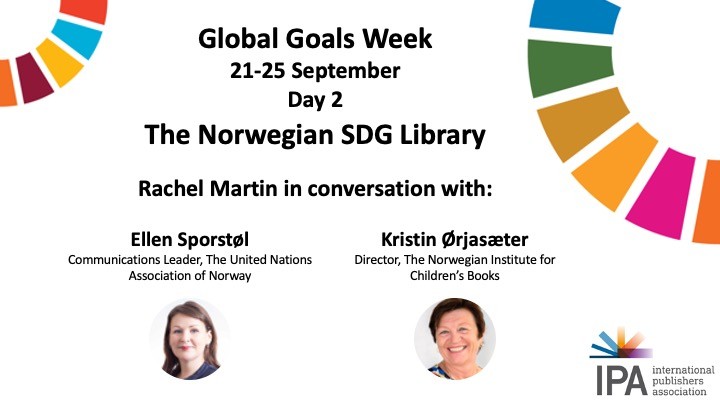Ellen Sporstøl, Communications Leader, The United Nations Association of Norway
Kristin Ørjasæter, Director, The Norwegian Institute for Children’s Books
What is the role do books play in helping to achieve the SDGs?
Kristin: The short answer is that books help children make up their own mind on things, even if the Sustainable Development Goals seem of a little local relevance. For example, most Norwegian children do not experience poverty. Reading about a protagonist who does, creates identification. In children’s literature, protagonists take action, they deal with whatever obstacle comes their way in a constructive manner. When the protagonist resonates within the reader’s mind, the reader understands the experience and is able to reflect on that theme, even if they don’t have firsthand experience.

- Baerekraftsbibliotek logotype
How important is it to teach children to live more sustainably through books?
Kristin: Whilst many children are engaged with the themes represented by the SDGs, some still feel distant from these big social problems. Books can inspire children to reflect individually and relate the themes to their local situation.
In the Norwegian version of SDG Library, we have a variation of books from cook books through health information to novels and detective stories, all in our own language. These books deal with the themes that touch upon the challenges that the SDGs aims to solve.
It is really important that the Norwegian SDG Library features good books whose content will resonate with the reader and inspire them to make their own reflections on the topics. High quality children’s books create the sort of reflection that stems from the readers own mind. The SDG Library aims to inspire children to read these books and talk about them, creating the potential to generate a lifelong interest in the SDG goals.
We need to inspire younger generations to take up the call for action. How have you done this in Norway?
Ellen: We have a lot of programs and activities for kids and actually meet about 100,000 people face to face each year. Most of them children and kids. Obviously, the SDG Library will be an important part of what we do. This is because we always trying to communicate that all people on Earth are part of the solution, even if they have not experienced some of these issues firsthand. Kids can do a lot of things and when they get inspired by these books, they can go out and pick up plastic waste in nature or they can help reduce food waste from their own home or in their school. Even in a rich country, such as Norway, where people have a lot of opportunity, it is still important to remind everyone that we have not solved all the problems. We have a lot of issues in Norway, for example with climate change and SDG 12, Responsible Consumption.
The SDG Library is a wonderful concept. What do you hope children who read the recommended books do to help achieve the SDGs?
Ellen: Our main objective is to get children interested and talking about the sustainable goals, and more importantly, possible solutions to solving some of these problems. We all recognize that we need to get kids on board with sustainable living, after all, they are the ones who will be living on Earth in the future with their children and grandchildren.
Also, it is very important to mention that by including kids in the discussion about future solutions, it has a soothing effect. Lots of kids pick up on conversations that adults have or see the headlines in the news and get worried about where our planet is heading. When they take part in the solution, it also takes away a lot of the anxiety. If we can get people starting the conversation, especially young people, they will inspire others to join and better understand that change starts with themselves.
Click here to read more about the Norwegian SDG Library

